Facts:
Time period of the project: January 2020 - December 2024
Financial support: The programme is funded by Formas – a Swedish Research Council for Sustainable Development (ID: 2019-02276 and 2019-02111) and by the Kjell & Märta Beijer Foundation.
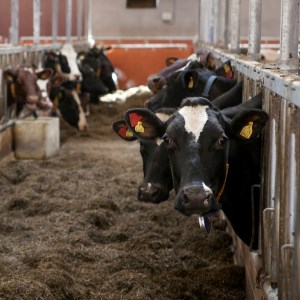
Agricultural systems need to improve in order to meet future challenges of an increasing human population and at the same time ensure good animal welfare and a minimal ecological footprint. This project focuses on how to improve animal welfare and health in dairy cattle production using sensor technology, with the potential to minimize antibiotic use by improving tools for disease control and management.
A primary component of the project is to use a real time location system to study the indoor movement and social interactions of dairy cattle. We will investigate the possibility to select for increased milk yield considering effects of social interaction with the purpose to improve the social environment of the cows.
We will use theory developed for indirect genetic effects (IGE). To model IGE, it will be essential to first understand the social interactions, as an IGE is a genetic effect of an individual on the trait value of the other individuals in the same group.
The location and movement of the cows will also be used to investigate disease transmission. An existing simulation model of spread and control of mastitis causing pathogens will be further developed using cow location data and pathogen data.
We will develop decision-support tools for farmers to minimize transmission of mastitis within their dairy farms in close collaboration with Växa Sverige.
This is a collaborative research programme between the Swedish University of Agricultural Sciences (SLU), University of Copenhagen (KU), Dalarna University (DU), Wageningen University and Research (WUR), RISE Research Institutes of Sweden and Växa Sverige.
2024-04-30
Earlier this month, the Swedish magasine Land published an article about our research.
A translated short extract from the interview with our project leader Lars Rönnegård:
The basic idea is that animal husbandry, in this case the well-being of the cows, can become of great importance for the agriculture of the future. That the social relationships also play a major role in the health of the cows and that it is therefore important to know which conditions are most favorable.
– We have known for a long time that cows are very social, now we are gaining new knowledge both about their network and how it works in free-range stables, says Lars Rönnegård.
In the study, three clear patterns have emerged; 1) experienced cows, which have given birth to the most calves, have the highest status, 2) calves that have grown up together continue to want to go together inside the free-range barn as adults, and 3) cows and their adult calves want to go together, even if they were separated already on the first day and then lived apart until they came to the stray stable.
– We don't really know how they can still recognize each other, but this was a pattern we saw, says Lars Rönnegård.
Read the whole article in Swedish here.
2024-04-15
Yesterday (April 14) our project manager Lars Rönnegård was interviewed on radio P4 Dalarna. It was about how to study the social network of cows and what makes a cow happy.
- A safe environment, good sleeping booths and food, access to water, but also being able to hang out with other individuals, they are extremely social. If they feel better, the idea is that they will also give more milk, Lars said.
Listen to the interview (in Swedish)
2023-07-14
The first day of the meeting we presented our research. Lars Rönnegård talked about the programme as a whole. Postdoc Keni Ren described her statistics research on indoor positioning data for studying movement and social interactions among cows, Doctoral student Ida Hansson talked about dairy cows social contacts and potential effects on milk yield, and Postdoc Hector Marina explained how to understand the dynamics of cow interactions, the implications and possible applications of cows social contact networks.
Senior lecturer Maya Gussmann talked about mastitis transmission and how to study the disease using simulation models. Doctoral student Svenja Woudstra described her studies on transmission pathways and infection durations of some mastisis causing bacteria.
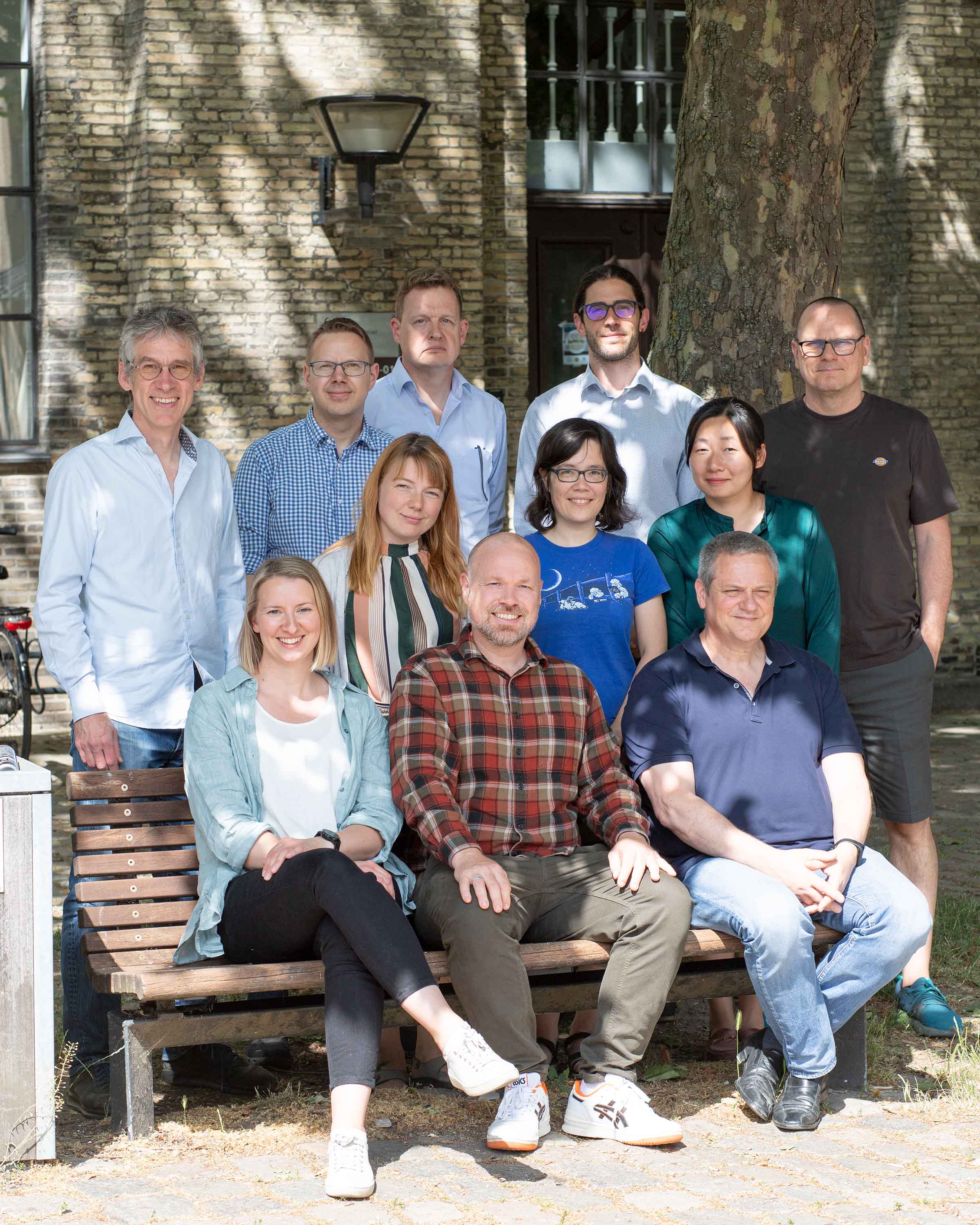
Participants, who attended the meeting on site in Copenhagen, June 15-16.
Top row: Lars Rönnegård, Matti Pastell, Piter Bijma, Hector Marina, Per Peetz Nielsen
Middle row: Svenja Woudstra, Maya Gussmann, Keni Ren
Bottom row: Ida Hansson, Carsten Kirkeby, Volker Krömker
Additional participants attended online. Photo: Lisa Beste
While day one was partly an outreach event, with invited stakeholders and others participating online, day two was more of an internal workshop. We discussed our deliverables, scientific papers in pipeline and how we will eventually sumarize the programme in our final report.
2023-04-11
In November-January Lars Rönnegård and Keni Ren, together with colleagues, supervised engineering and computer science students from Uppsala University on computational research projects, within a course, using data from dairy farms.

Three of the students at the course. Photo: Tomas Klingström
One of the students' projects used data from our "Precision livestock breeding" research. Read more about these studies and conclusions presented in a poster. In the project, automatic classification (using CowView) was compared to observations made by humans, when monitoring cow activities. For example, the results show that 155 of 171 periods of feeding started earlier and ended later in CowView than in the observer's notes.
These student projects are examples of how the combination of ambitious students and accessible data can qickly generate interesting results.
2023-01-27
Our colleague Hector Marina has received a Spanish price, the Enrique Coris Gruart Award, for the statistics research he did during his PhD studies.
– To compete for the prize, I presented one of the seven chapters of my thesis to the jury. It’s about using statistical methods to combine genomic animal information, to make breeding more efficient. This can reduce a lot of costs for sheep farmers and the sheep cheese industry, I think that’s an important part of why I got the prize, says Hector Marina.
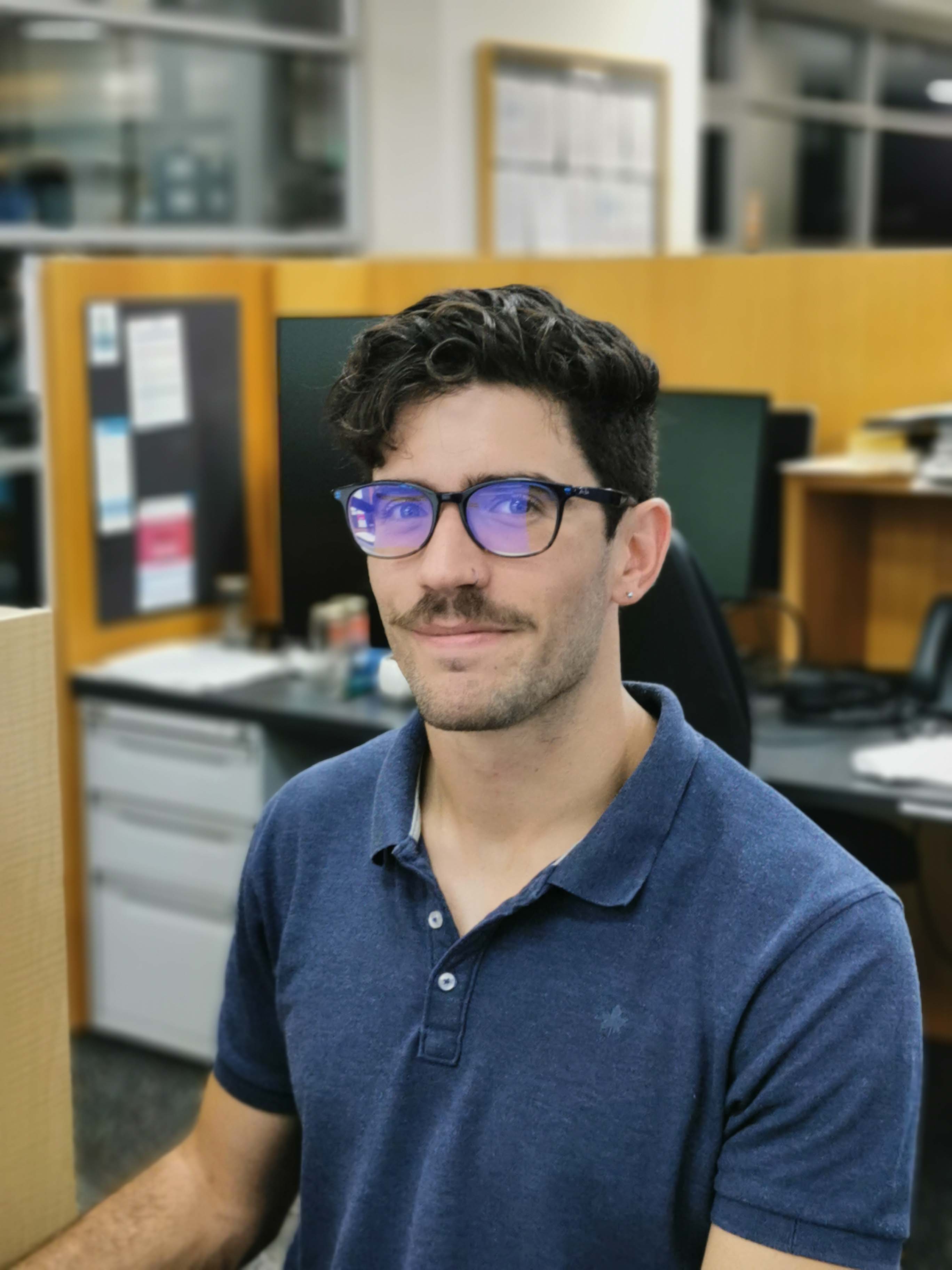
Hector Marina.
The prize gives Hector an opportunity to spread the news about the research to the society.
– Transmitting information to people is more important to me than getting prize money or getting recognition for the hard work, he says.
And as a prize winner Hector Marina actually already received quite a bit of attention from the press in Spain, for example in an article in the newspaper ABC España.
– I didn't expect such a resonance to be honest, he says.
The awarded research is about the development of a bridging methodology between genomic sequencing methods. The new method will increase the accuracy and reduce the time required to achieve the objectives (e. g. animal disease resistance) proposed in breeding programs.
Hector is invited to a public ceremony at the Faculty of Veterinary Medicine of Zaragoza in Spain, where the award will be presented and he will receive the prize money (3500 Euros).
– It will be in May, and I think it will be really nice, he says.
Facts:
The original title of Hector Marina’s research article is Evaluation of the accuracy of microsatellite marker imputation from a SNP chip in Assaf sheep.
The title of the Enrique Coris Gruart Award call was Animal Husbandry, Animal Production and Animal Food Science and Technology, as well as related Basic Sciences.
Hector Marina’s title of the work for the award: Algorithms that support farmers in reaching for the future.
2022-12-09
We are happy to announce that our project colleague Per Peetz Nielsen successfully gave his docent lecture at the VH-faculty at SLU some days ago.
Per is working at RISE (Research Institutes of Sweden), he is an ethologist, and the lecture had the title “Shift towards recognizing the importance of social network and happy animals”.
He talked about different techniques to measure the welfare of animals, especially methods to study the social bonds between dairy cows, as well as hierarchies, and how regrouping affect the cow behavior and milk production.

“Cows have really strong personalities. It’s not a surprise for a lot of us, but what was actually a surprise, when we looked at the data, was that there are cows that can be perceived as introvert or extrovert.” - Per Peetz Nielsen
The lecture is available online for a couple of weeks on SLU Play: Docent Lecture VH fak 30 nov 2022 - Per Peetz Nielsen - SLU Play - Swedish University of Agricultural Sciences
2022-10-10
On September 12-13, five project members visited one of the commercial farms we are collaborating with in our studies. They performed an observation study on cows' feeding and resting activities.
– The time spent lying or feeding, by the cows, plays a vital role in terms of milk production. In this project, we used CowView systems to provide data on positions and zone-related behaviour (feeding, resting in a cubicle, walking or standing in the alley) for individual animals. This observation study will help us to get more detail of the data quality from the real-time locating system, says Keni Ren.
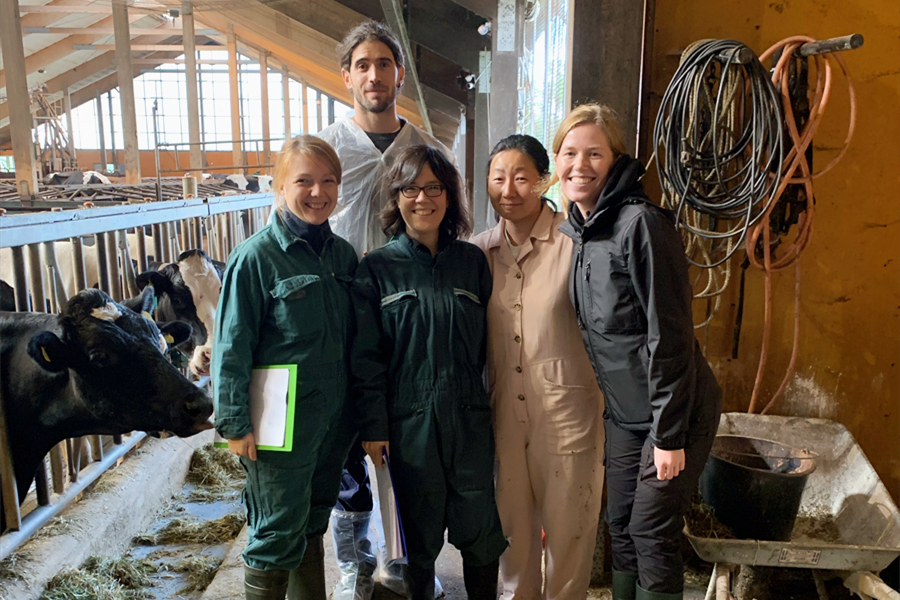
From left to right: Svenja Woudstra, Hector Marina, Maya Gussmann, Keni Ren, Teresa Johansson. Photo: Hanna Johansson
The result of this observation study will be used to validate the accuracy, sensitivity and specificity of cow activity data provided by the CowView system. The validation will be performed by comparing data automatically obtained from the CowView system with those obtained by observation study.
– We also would like to develop an efficient filter to improve the quality of the cow activity data in the feeding and cubicle areas, by removing short glitches of incorrect activities, says Keni Ren.
2022-10-05
Lars Rönnegård has participated in “Forskarfredag”, 2022, which is a national event in Sweden organized as part of European Researchers’ Night. He gave presentations for school classes about what makes the cows thrive in the barn, and how to study it.
He was also interviewed on Swedish radio’s program ”Vaken med P3 & P4” in connection to this.
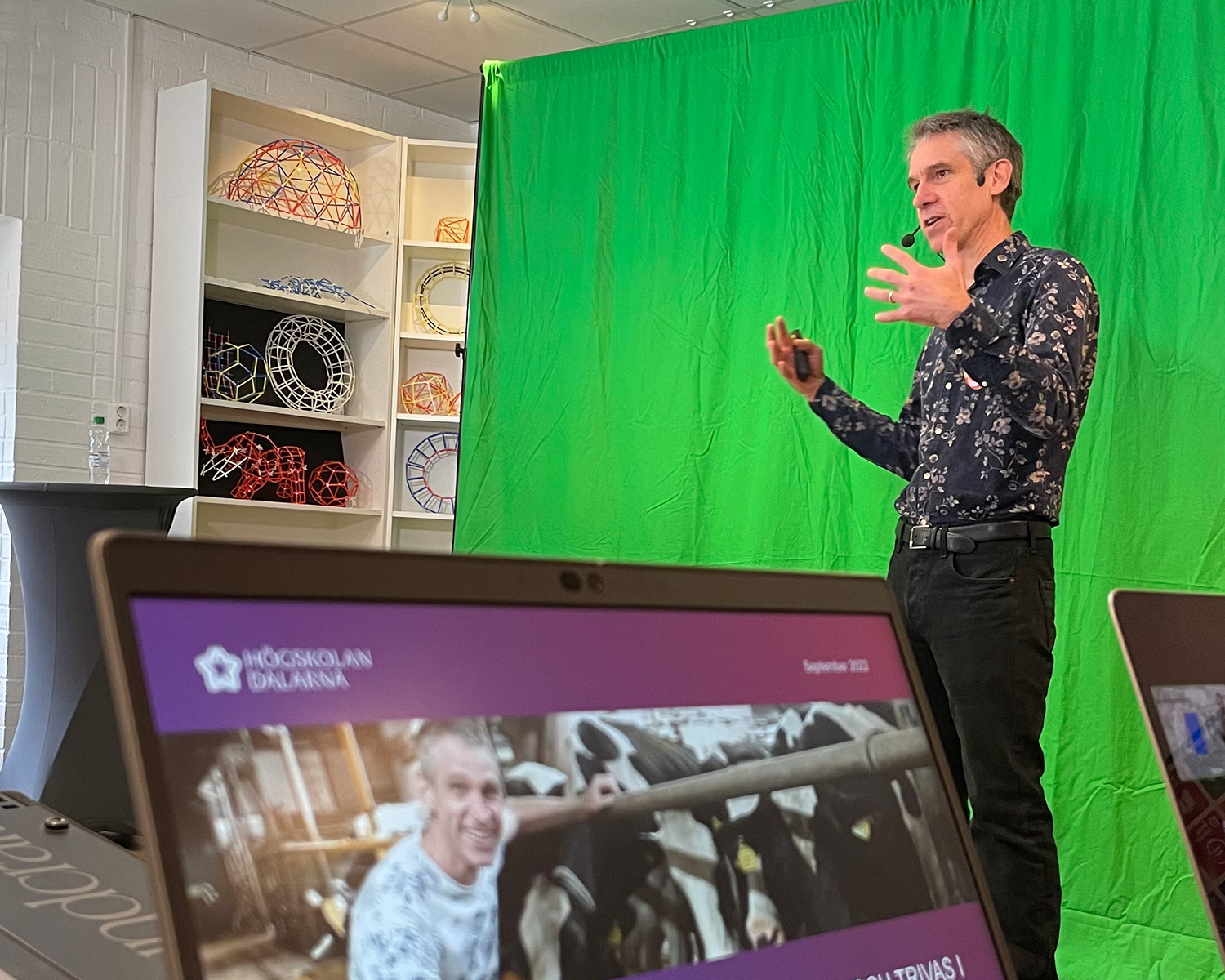
Lars Rönnegård in front of a green screen at the 2047 Science Center in Borlänge, where he gave an online presentation, in connection to this year’s Forskarfredag (“Research Friday”, an event about science for young people). Photo: Mikael Granberg
Högskolan Dalarna (where Lars does parts of his research) has been involved in Forskarfredag recent years, and Lars Rönnegård has previously talked about his research on the domestication of foxes, at the event.
– Our current project on the social interaction of cows is among the most enjoyable projects I have worked on and I wanted to take the chance to talk about this research to high school students around Sweden. In addition, I worked as a high school teacher for a year in the 1990s in Mora and I am passionate about the knowledge that students get during high school, says Lars Rönnegård.
He received many funny, unexpected and curious questions from the young students. What makes a cow feel well? Does a cow moo when it feels well? What is AI? Could the research have any negative consequences? Are you comparing different types of farms? Do you eat meat? Does being a researcher make good money? Why are you a researcher? Why do you study cows?
– This type of arrangement is a way to show young people the importance of research. To arouse curiosity and increase knowledge about what research is. It was great fun to be a part of this. The 45-minute meetings went far too quickly, says Lars Rönnegård.
2022-01-19
During the autumn term of 2021 three groups of students from Uppsala University joined our research team.
Elias Estensen, Arvid Forsberg and Alexander Palfelt worked on a project with the title “Software optimization and parallel computing of social network construction in dairy cows” under the supervision of Keni Ren and Freddy Fikse.
They optimized an algorithm in terms of speed and memory usage, to investigate how disease spread and milk production is affected by social interactions among dairy cows. Have a look at their poster.
Dap de Bruijckere, Emil Helmryd Grosfilley and Junjie Chu worked on a project with the title "Dynamic social networks in dairy cows" under the supervision of Moudud Alam and Lars Rönnegård.
The students analysed the monadic, dyadic and polyadic features of dairy cows' social networks and investigated the dynamics of the networks. You find their poster here.
Max Mesch Karlsson, Samuel Rosén and Marcus Bonnedahl did a project with the title "Detecting and measuring synchronized behaviour in a dairy herd" under the supervision of Lars Rönnegård och Keni Ren.
The aim was to create support tools for analysing synchronized behaviour in
dairy farms, including a summary of dairy herd movement, social interactions and behaviour. Here is the link to their poster.
2021-10-07
Thursday last week, Keni Ren successfully defended her doctoral thesis at Umeå University. Keni has been working in our project in parallel with the completion of her doctoral studies.
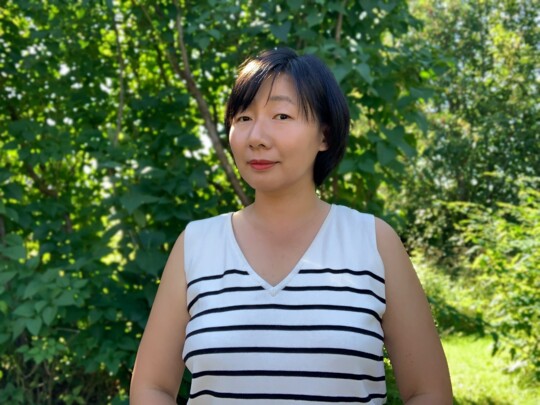
Keni Ren has explored the possibilities of using a combination of computer vision and sensor technology to study animal behavior in zoos and livestock farming environments. Read more about Keni Ren's doctoral thesis in a press release from Umeå University.
2021-09-08
On the 2nd – 3rd of September we gathered our project members and invited guests and had a workshop on precision livestock farming and social interactions in dairy cattle. Some of us were present in Copenhagen while some joined via Zoom.
”It was great meeting everyone in Copenhagen and although some participants attended online it felt like everyone were in the meeting room. Considering that it was only two half days we were able to cover a wide range of topics and discuss research in detail all the way from data interpolation and Streptococcus dysgalactiae to predictions of pig feed and strategies for handling co-authorships”, says Lars Rönnegård.
Marc Ahlse from Sony in Lund joined the meeting online and told us the story about how the company entered into the dairy industry, solving problems using the Sony technology to monitor cows. “Dairy cows are both high tech and low tech at the same time”, he said.
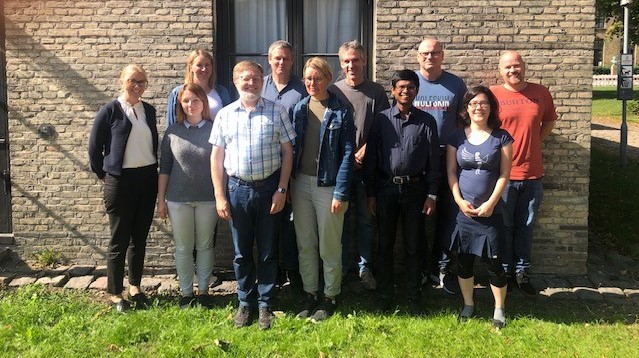
From left to right: Anna Silvera, Svenja Woudstra, Ida Hansson, Freddy Fikse, Volker Krömker, Anna Skarin, Lars Rönnegård, Moudud Alam, Per Peetz Nielsen, Maya Gussmann, Carsten Kirkeby Missing in the picture are: Keni Ren and Mikhail Churakov who participated online.
2021-06-30
In April 2021 several members of the group participated in the virtual Precision Livestock Farming Seminar arranged by KU Leuven, Belgium.
Lars Rönnegård gave a presentation with the title "Cow Social Interactions and Disease Transmission" - click on the link if you want to see the presentation.
Below are the abstracts from the other presentations at the workshop.
Lars Rönnegård, Freddy Fikse, Volker Krömker, Carsten Kirkeby & Per Peetz Nielsen
The social interaction between cows is important, both for production and animal welfare. The goal of our research is to increase animal welfare through improved understanding of cows’ social interaction, with potential to improve animal welfare and production.
In this project, we collect data with different types of automated systems and sensors on two farms, one in Sweden and one in the Netherlands, with over 200 dairy cows per farm. The individual position of each cow is registered once a second with an ultra-wideband system and stored on a common server since February 2020, to track the behaviour of the cows. Other individual cow data (lactation number, milk production, milk order, claw health, etc.) are also collected. Furthermore, during the period June - October 2020, bacterial samples were sampled regularly from each individual teat on all cows as well as samples from lying stalls and other exposed areas of the barn, in order to investigate disease transmission. Recently, cameras were installed on the Swedish farm to enable observational studies. All in all, this is a world-unique data set, carefully collected to specifically answer the questions in the project.
We investigate how social interactions affect disease transmission with a focus on mastitis and we will develop a digital decision-support tool for dairy farmers to minimize mastitis transmission. Furthermore, we aim to investigate how breeding for social interactions might affect production, in collaboration with Växa Sverige.
In our talk we will give an overview of the data we have collected so far, present some preliminary results, and wish to discuss further ideas to develop in the project.
Anna Silvera, Ida Hansson, Keni Ren, Per Peetz Nielsen, Lars Rönnegård
Cattle is a gregarious species who lives in herds, based on dominance hierarchies, where they form social relationships with each other. These social relationships are based on interactions between individual animals and can be categorized into agonistic interactions (socio-negative) and affiliative interactions (socio-positive). The agonistic behaviours include behaviours connected to dominance and can be described as aggressive acts and responses to aggression. Examples of agonistic behaviours are chasing, head butting and fighting. The response is mainly avoidance and replacement, but could result in confrontation and fighting. Affiliative behaviours include proximity, allogrooming (social licking) and providing food and protection to individuals in the herd. Allogrooming is a behaviour that reinforces social bonds, is suggested to reduce tension and have a strong link to positive animal welfare. The social preferences of cattle are also reflected in their spatial proximity to others in the herd. Cows form preferential relationships with some individuals, while avoiding others.
In this study we will perform behavioural observations from video recordings in a commercial dairy herd. Both agonistic and affiliative behaviours will be identified. All individuals in the dairy herd is connected to a real time location system (RTLS) (CowView, GEA Farm Technologies, Bönen, Germany) and their position in the barn is continuously recorded approximately every second. The aim with this study is to investigate if the RTL-system can be used to identify and separate affiliative and agonistic social interactions in cattle herds. The results in this study will be used to further investigate the possibility to use automatic identification of social interactions to asses animal welfare and the prospects of including this information in future breeding goals.
Mikhail Churakov, Anna Silvera, Per Nielsen
Cows spend a significant amount of their time lying down in bedding areas that are divided into individual cubicles on most commercial dairy farms. The choice of cubicles for sleeping, drowsing and ruminating is not random, previous studies suggested that cows’ preferences depend on their social rank, age and stage of lactation.
Here, using data from real-time location system (RTLS) we describe cubicle choice preference of cows on two commercial dairy herds in Sweden and the Netherlands. We summarise time spent in cubicles by groups of cows defined by parity or stage of lactation, and in specific areas inside the barn. Preliminary results suggest that cubicles closer to feeding areas are preferred by all cows, older cows prefer to occupy cubicles that are also closer to the milking area, and the stage of lactation also affects cubicle choice. However, a robust methodology to assess cubicle occupancy patterns is not yet established.
This study is important to better understand resting space usage by cows inside the barn. More optimal bedding arrangements can lead to less competition for space and, in turn, for less stress, better animal welfare and higher productivity of dairy cows. Data-driven decisions are at the heart of precision livestock farming and here we show how RTLS positioning data can be leveraged.
Ida Hansson, Keni Ren, Anna Silvera, Lars Rönnegård, Per Peetz Nielsen, Svenja Woudstra
The social environment caused by neighbouring cows in a dairy herd greatly impacts the well-being and the production of a cow. Social interactions between individuals can be categorized into aggressive and positive interactions and can, therefore, both stress cows and have a calming effect. Cows have shown to differ in their tendency to stay close to other individuals, and some cows seem to create preferential bonds with individuals with similar attributes. However, it is not fully understood what characteristics determine the number of proximity interactions a cow has with other individuals. Advanced sensor technology can be used to measure indoor movement and dairy cattle's social behaviour. This study aims to collect positioning data of dairy cattle in two herds, with approximately 200 cows per herd, using an ultra-wideband indoor positioning system (CowView, GEA Farm Technologies, Bönen, Germany). The position of each individual is recorded every second, with an accuracy of 30 cm. The total duration of proximity interactions each cow has is registered during a 14-day study period, and a distance threshold of 2.5 m between two cows is used. With this real-time location system (RTLS), the proximity interactions between two individuals are also predicted to be in different barn areas, such as at the feeding table, in the walking alley, or the cubicles.
Furthermore, individual attributes, such as parity and days in milk, will be investigated if they affect the total duration of proximity interactions a cow has. This study aims to understand how cows associate in order to further understand disease transmission and the assessment of indirect genetic effects in dairy cattle. It is an ongoing project, and some preliminary results will be presented. We wish to discuss methodology when using automated sensor data to monitor individual animals' interactions, e.g. selection of proximity thresholds, and how an interaction with impact potential should be defined.
Svenja Woudstra, Maya Katrin Gussmann, Carsten Kirkeby, Per Peetz Nielsen, Volker Krömker
Mastitis, the inflammation of mammary glands, is one of the most important health issues in dairy cow herds worldwide. It has a high economic impact due to milk production and quality losses as well as costs associated with treatment, prevention and premature culling. Furthermore, it is the major reason for the use of antimicrobials in dairy farms and an important animal welfare issue. Most mastitis cases are caused by bacterial pathogens that enter the mammary gland through the teat channel. Reservoirs of pathogens can be the environment or infected udder quarters. It is postulated, for pathogens spreading contagiously from animal to animal, that indirect contact of udder quarters via fomites during milking (e.g. consecutive use of the same milking equipment, or pathogen transmission via milkers´ hands) is the primary mode of transmission. Still, to date, no study has estimated the impact of these transmission pathways.
Nowadays, modern milking parlor technology allows the recording of cow positions at consecutive milkings and thereby enables long-term tracking of indirect cow contacts during milking.
Therefore, we are currently conducting a research project to determine if and how the level of previous indirect contact to infected udder quarters (through different pathways) during milking affects the Odds of an udder quarter to acquire a new intramammary infection. Over 12 consecutive weeks, data on cow positions during milking was collected from one Swedish dairy herd. Over the same period, milk samples were collected from all lactating cows (n=263) at afternoon milkings in 14-day intervals. All milk samples were analysed by standard milk microbiology with consecutive species confirmation by MALDI TOF-MS. For species that caused a relevant number of new infections throughout the sampling period, strain typing will be carried out. Mixed logistic regression models will be used to calculate species-specific (if possible strain-specific) Odds ratios for udder quarters to acquire a new IMI or not depending on the level of previous indirect contact to infected udder quarters during milking.
At the workshop, we intend to present the used methodology and would like to discuss the planned analyses.
2021-01-14
During the autumn term of 2020 two groups of students from Uppsala University joined the research team.
Li Ju, Linus Kanestad and Gustaf Andersson worked on a project with the title “Construction of a database storing cow information for SLU research” under the supervision of Keni Ren. The database allows easy access of the collected data for individuals cows. You can see their poster by following this link.
Torsten Malmgård and Björn Sparresäter worked on a project with the title "Detecting social interactions between cows" under the supervision of Mikhail Chirakov and Lars Rönnegård. The students looked at the incidents of displacement at the feeding area to detect avoidance behavior. Have a look at their poster by following this link.
2020-10-15
Lars Rönnegård has presented the project at the Workshop on Modelling in Biology and Medicine on Oct 15th 2020. His presentation with the title "Social interactions in dairy cattle" is available on YouTube. You can also download the slides of the presentation.
2020-09-08
On 7th - 8th September we gathered all participants in the projects and some invited guests in a workshop on cow social interactions and disease transmission at SLU in Uppsala. We updated each other on background and status of the different parts of the projects and planned the upcoming work. Most team members could be present in Uppsala, some joined via zoom.
Thanks to all particpants for a fun and rewarding workshop!
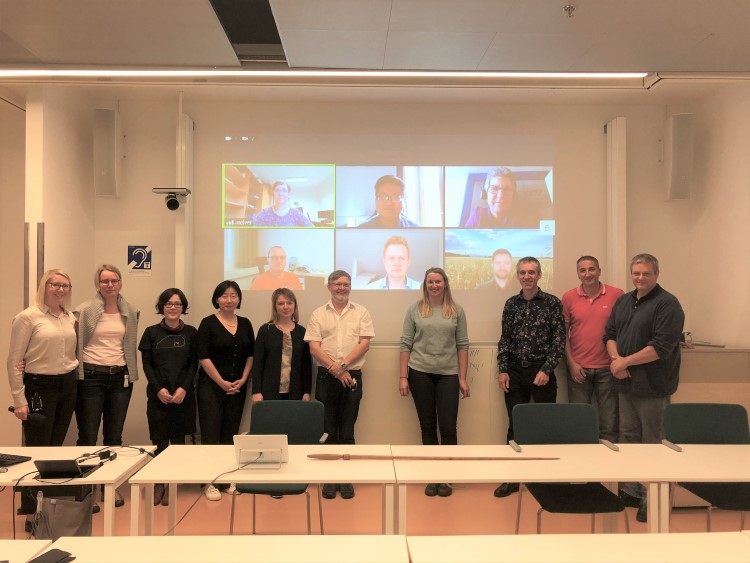
Standing from left to right: Anna Silvera, Anna Skarin, Maya Gussmann, Keni ren, Svenja Woudstra, Freddy Fikse, Ida Hansson, Lars Rönnegård, Tariq Halasa , Volker Krömker
On screen: Nina Melzer, Zhuoshi Wang, Isabelle Veissier, Per Peetz Nielsen, Piter Bijma, Mikhail Churakov
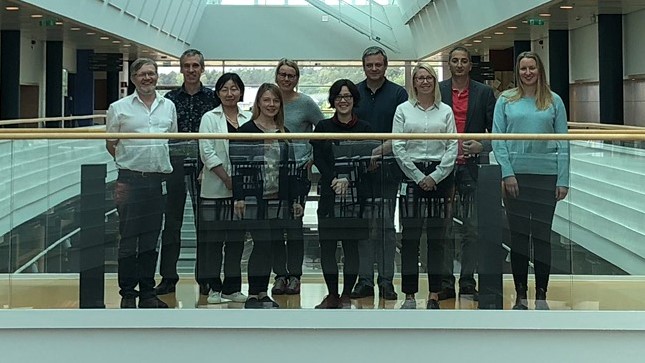
From left to right: Freddy Fikse, Lars Rönnegård, Keni Ren, Svenja Woudstra, Anna Skarin, Maya Gussmann, Volker Krömker, Anna Silvera, Tariq Halasa, Ida Hansson
2020-06-15
We have recruited two new PhD students - welcome to the team!
Svenja Woudstra, PhD student in the research group of Prof Volker Krömker at the University of Copenhagen
Title of project: Infection dynamics in bovine mastitis
What is the aim of your project?
"The aim of my PhD project is to generate further knowledge on the transmission of mastitis causing pathogens within dairy farms. Traditionally these are categorized in two groups, environmental and contagious. During the past two decades, this categorization has been challenged as evidence of environmental pathogens spreading as contagious pathogens and vice versa has emerged. Additionally, no study has quantified the different transmission routes in order to unravel how many new infections actually originate from the environment and how many from the milking parlor. Therefore, we will take samples at one farm every two weeks for half a year and follow the dynamics of the infections. The outcome of this project shall provide further information for farmers and veterinarians on transmission routes and help to evaluate the importance of measures to prevent the spread of mastitis causing organisms. "
What sparked your interest in this project?
"I have a background as a veterinarian and have worked for some years in the Institute of Food Quality and Food Safety in Hannover, Germany. I have focused on the potential role of Clostridia in chronic diseases of cows and even did a doctorate within that field. Since I mostly worked in the laboratory, I then wanted to go on to more field work and started to work at the Clinic for Cattle in Hannover within a German national prevalence study on dairy cow health.
I got interested in this PhD project for two reasons. I really wanted to continue to work with dairy cows and learn more about mastitis. My supervisor Volker Krömker is an excellent researcher within the field of bovine mastitis and everything fell into place very nicely."
Ida Hansson – PhD student in the research group of Prof Lars Rönnegård, Department of Animal Breeding and Genetics, SLU
What is the aim of your project?
"The aim of my PhD project is to study indirect genetic effects of social interactions of cows. To start with I will analyse data from two farms, where the positioning of every individual cow is recorded every second. I am going to look for evidence for any specific behavior, including both positive and negative relationships. I will combine the results with genetic data, and later on also add observations studies. The overall goal is to include indirect genetic effects in breeding. This has not been done to a large extent in cows before."
What is your background and how did you get interested in this PhD project?
"I have a Bachelor degree in Animal Sciences from SLU and did thereafter a Masters in Quantitative Genetics and Genome Analysis at the University of Edinburgh in Scotland. For the last few years I have worked as a breeding advisor for dairy farmers in Uppland at Växa Sverige. I have helped the farmers with breeding strategies and breeding plans to match cow and sire.
I have always had the idea of doing a PhD in the back of the head but wanted to wait for the right opportunity. I also wanted to gain some practical experience first, which I did through my work at Växa Sverige and previous positions. When I saw the advertisement for a PhD position in Lars Rönnegårds group and this project I knew it was time."
2020-01-08
On the 8th of January 2020, a first meeting with all participants was held at SLU in Uppsala. The coming months we will focus on employing three postdocs and two doctoral students at SLU and University of Copenhagen.
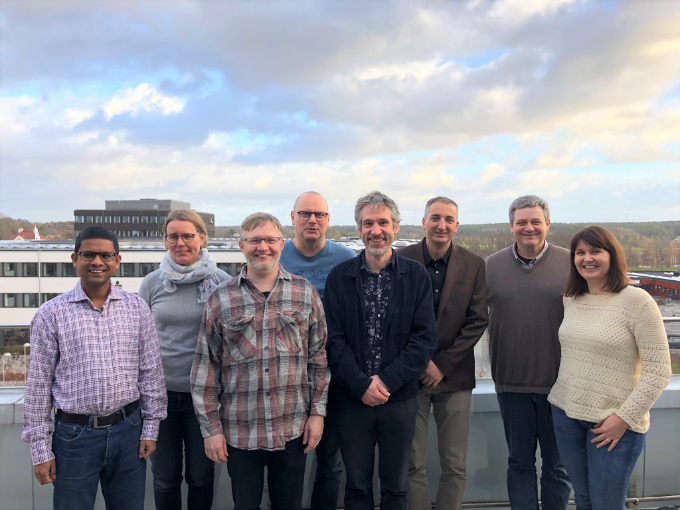
From left to right: Moudud Alam, Anna Skarin, Freddy Fikse, Per Peetz Nielsen, Lars Rönnegård, Tariq Halasa, Volker Kromker, Natalie von der Lehr
Our PhD student Ida Hansson and Postdoc Svenja Woudstra have found interesting patterns of how cows enter the milking parlor. This new knowledge is important to take into account, when studying the spread of diseases in the barn.
In a modern barn where the dairy cows can move freely, the waiting area in front of the milking parlor can sometimes be quite busy. Since diseases, for example mastitis, have a high risk to be transmitted at the milking parlor, it is important to know more about the cows’ behavior in this area. Therefore, Hansson and Woudstra have explored the effect of lactation stage and parity on the milking order of the cows at a dairy farm in Sweden.
– We could see that young parity cows and early lactation cows tend to enter the parlor earlier than higher parity cows and cows in later lactation, says Ida Hansson.
Why do the cows behave this way?
The fact that the early lactation cows show a different behavior than cows in later lactation, could be related to the time the cows have spent in the group and their familiarity with the other cows, which seem to affect the number of contacts the cows have with each other. This might explain why early lactation cows also seem to have similar behavior as low parity cows.
– We know from earlier studies that cows within the same parity spend more time together, so perhaps they actually move to the milking parlor together. Another theory is that young cows try to enter the milking parlor as early as possible, because they want to leave the crowded waiting area, says Ida Hansson.
Ida Hansson is an agronomist and Svenja Woudstra is a veterinarian. This study is a result of their interdisciplinary discussions within our project.
– In most herds, younger cows are less infected with contagious mastitis pathogens than older cows and maybe the order of milking cows contributes to that. It’s an important piece in the puzzle to know that cows don’t mix in a random order, when studying the spread of pathogens, says Svenja Woudstra
The article, in which the study was reported, is a so called short communication in a special issue on Animal Behavior, in a section about health, behavior and wellbeing in the journal JDS communications:
Association of parity and lactation stage with the order cows enter the milking parlor
Saturday March 16:th Lars Rönnegård was the research columnist from Högskolan Dalarna in the newspaper FaluKuriren.
One of the biggest challenges of our time is the use of natural resources and depletion of biological diversity. Animal husbandry and food production play an important role here. In order to achieve more sustainable animal husbandry and strengthened agriculture, researchers are now focusing on the social interaction of animals.
With the help of new technology, Lars Rönnegård's research group tries to understand what determines the well-being of cows - and what their "social network" looks like. Here he talks about this work, in the first "research column" in FaluKuriren (in Swedish).
Colleagues in our project have investigated where Corynebacterium (C.) species can be found in the housing environment of dairy cows. By taking various kinds of samples from different sites in a barn, our researchers could show that many Corynebacterium species are frequently hiding in e. g. the bedding material and on the floor in front of the drinking trough. C. bovis, the most relevant Corynebacterium species with regard to intramammary infections, was not found in the environmental samples.
Why is this research important?
– In mastitis research we distinguish between pathogen transmission from cow to cow and infections due to pathogens residing in the environment. To make the daily management of dairy cows easier, and prevent infectious diseases, we often assign bacteria to one of these categories, says Svenja Woudstra, PhD student and first author of the study.
Svenja Woudstra is a veterinarian. She has been working with dairy cow health for ten years.
– As far as we know this is the first study describing where Corynebacterium species can be found in a barn. Several of the species, causing intramammary infections, were found in the housing environment. But the dominant bacteria causing masititis, Corynebacterium bovis, could not be found in the environmental samples. Therefore, our study indicates that environmental reservoirs are of little relevance in this case.
How will you proceed with this knowledge?
– The most interesting thing to do now, would be to compare strains of Corynebacterium bovis between different cows and see if the same strains are present in the udder quarters of different cows. This would indicate that this bacterium really spreads from cow to cow during milking.
This study was published in the journal Pathogens 2023
Researcher Keni Ren and her colleagues have identified an accurate method for interpolating missing data in systems for monitoring dairy cows in the barn. This knowledge can be used to improve the indoor positioning systems used by modern farms and researchers to study cows’ activities.
Cows that are allowed to roam freely indoor, in a barn, spend their time resting, walking, standing, feeding and visiting the milking robot. Their individual behavioral patterns and social activities are important for cow welfare and for avoiding disease outbreaks.
Real-time systems for monitoring animals, e. g. ultra-wideband (UWB) technology, are increasingly used but not perfectly accurate. Almost always, there will be a lot of time-gaps in this kind of studies, where data are missing due to physical structures in the barn, calibration problems or communication failures between the tags carried by the cows and the receiver anchors in the locating system.
In the field of statistics there are a number of interpolation methods used to improve the quality of data sets, by predicting and estimating the unknown data. Keni Ren and her colleagues decided to find out which interpolation method would be the most accurate one to use when studying the positioning data for dairy cows inside a free-stall dairy farm.
A new study from the researchers in the project Precision livestock breeding – improving both health and production in dairy cattle, at the Swedish University of Agricultural Sciences, shows that some cubicles in the barn are more popular than others. High parity cows, that have calved several times, more often occupy the cubicles close to the feeding table and milking station, and the cubicles close to the feeding area are occupied the most.
– Good possibilities for cows to sleep and rest is important for the animal welfare. A dairy cow spends approximately eleven hours per day lying down to sleep, rest or ruminate. Studies have shown that cows prioritize the possibility to lie down before feed when being deprived of both, which show that lying down is a behavior cows are highly motivated to perform. This is one reason to why it is important to provide enough cubicles in a modern dairy farm, says Anna Silvera who is an agronomist, ethologist and one of the researchers behind the study.
In a pilot study, at one of SLU´s research barns, Keni Ren and her colleagues show that a combination of sensors and cameras gives a really good picture of what is going on among the cows in the barn.
– Data from cameras add a whole new dimension to social behavioral studies, says Keni Ren who recently defended her doctoral thesis at Umeå University.
The method of using cameras as a complement to real-time locating sensors was investigating with a focus on the social interactions between cows gathering around the feeding table, for example when younger individuals are introduced to an existing herd.
Read more about the pilot study!
I det senaste nyhetsbrevet från SLU infrastrukturen Gigacow uppmärksammas projektet som ett exempel hur man kan utnyttja befintlig teknik för ny forskning, i det här fallet för att studera hur kor rör sig i ladugården och interagerar med varandra genom att använda sensorer som samlar in positionerna på korna varje sekund.
Läs mer i Gigacows nyhetsbrev (sida 4-5)
Tänk dig att du är en ko i en ladugård. Du finns där, 24 timmar per dygn, 7 dagar i veckan, tätt tillsammans med några hundra andra individer. Vad är det egentligen som får dig att må bra och trivas? Kanske är det friskt och gott vatten och att ha tillräckligt med mat. Torra fötter, med mycket strö på golvet är inte så dumt. Eller är det precis som för oss människor viktigt att känna trygghet och tillit, att inte vara rädd och att inte vara stressad.
Det är lätt att börja tänka på rent fysiska faktorer när det kommer till djurhållning, men det sociala samspelet är av lika stor betydelse. Hur individerna i en ladugård samverkar med varandra spelar roll. Vi vet att stressade kor mjölkar sämre, men vi vet väldigt lite om hur djurens sociala liv ser ut. Vi måste därför öka vår kunskap om de sociala samspelen i en ladugård. Den digitala utvecklingen ger oss helt nya möjligheter att studera de sociala samspelen.
Vi lever inte bara i en ladugård, by eller en stad, vi lever på ett jordklot. Vi är många på klotet, vi blir allt fler, och vår medelinkomst ökar. Det leder till ökad efterfrågan på kött, mjölk och andra djurprodukter. Hur framtidens jordbruk på ett hållbart och rättvist sätt ska kunna öka sin produktion är en av de största utmaningar mänskligheten står inför. En djurhållning som ökar sin produktivitet på bekostnad av djurens hälsa och välfärd kommer även att påverka miljön negativt.
Vi vet redan idag att dåligt reglerad djurhållning kräver mer användning av antibiotika, vilket globalt sett är ett enormt problem. Det ger resistensutveckling hos bakterierna, och i förlängningen sämre möjligheter till behandling av både människor och djur. För att kunna möta den ökande efterfrågan på animalieprodukter behöver vi öka produktionen samtidigt som miljöpåverkan måste minimeras.
Det är här djurhälsa och socialt samspel i lagårdsmiljö blir viktigt. Målet med vårt forskningsprojekt är att i framtiden kunna bedriva avel på mjölkavkastning, där sociala interaktioner mellan kor byggs in i avelsmodellen, för att på så sätt kunna öka produktion och samtidigt öka djurvälfärden. Dessutom kommer vi att studera hur sociala interaktioner påverkar sjukdomsspridning för att på så sätt ge praktiska råd till mjölkbönderna.
Hur kan vi ta reda på mer om det sociala samspelet? Det är ett snabbt växande forskningsfält där det finns ny avancerad teknik att tillgå för att samla in information djurens beteende. Man kan idag följa hur korna rör sig i ladugården och hur de mjölkar med hjälp av data från olika sensorer och mjölkningsrobotar. Det finns redan mycket data som samlas in med den nya tekniken och vi vill använda dessa data för att ta reda på om en ko beter sig vänligt eller aggressivt. I samarbete med storskaliga projekt för datainsamling kommer vi inom en snar framtid ha tillgång till ännu mer data och en del av projektet är att precisera vilken typ av data vi behöver för att kunna dra slutsatser om hur miljön och det sociala samspelet påverkar produktionen.
Det sociala samspelet påverkar även avelsmöjligheterna. Ett djurs egenskaper hänger samman med dess gener. När djurets egenskaper påverkar omgivande djurs produktivitet kallas det "indirekt genetisk effekt" (IGE). Hur stor effekten blir hänger ihop med hur mycket individerna påverkar varandra, därför är det viktigt att kvantifiera och förstå det sociala samspelet mellan korna. Tidigare har man kunnat studera IGE vid djurhållning i liten skala av andra djurslag och framgångsrikt kunnat bedriva avel på dessa, men det är först nu som vi har teknik som möjliggör att kunna göra det i så stor skala som ladugårdsmiljön kräver. Att få med kornas sociala interaktioner i avelsprogram är alltså betydelsefullt, både för produktiviteten och för djurvälfärden.
Målet är att den enskilda bonden ska kunna märka av en ökad mjölkproduktion genom att korna har det bättre.
Vi kommer att angripa frågeställningarna i detta tvärvetenskapliga forskningsprojekt med forskare inom flera olika områden: statistik, husdjursgenetik, beteendevetenskap, och epidemiologi. För att besvara de frågor vi har behöver vi jobba brett och vi hoppas kunna hitta helt nya lösningar genom att samarbeta. En viktig del i projektet är att utveckla beslutstödverktyg för mjölkbönderna för att hantera sjukdomsspridning och på så sätt minimera användandet av antibiotika. Verktyget kommer att utvecklas med hjälp av datorsimuleringar och insamling av bakteriologiska stickprov från en mjölkgård.
Lars Rönnegård is the principal investigator of the research programme. Lars is a professor in statistics at Dalarna University and also holds a position as researcher at the Department of Animal Breeding and Genetics, SLU.
Per Peetz Nielsen is a researcher at RISE Research Institutes of Sweden and holds a PhD in Ethology.
Carsten Kirkeby is a senior researcher at the Institute for Veterinary and Animal Sciences, University of Copenhagen.
Volker Kromker is a veterinarian and professor in cattle health at the University of Copenhagen.
Freddy Fikse is employed by Växa Sverige and holds a PhD in Animal Science.
Anna Skarin is an associate professor at SLU with an expertise in animal movement.
Moudud Alam is an associate professor in microdata analysis at Dalarna University.
Teresa Johansson is a research assistant at the Department of Animal Breeding and Genetics, SLU.
Keni Ren is a postdoc at the Department of Animal Breeding and Genetics, SLU.
Hector Marina is a postdoc at the Department of Animal Breeding and Genetics, SLU.
Svenja Woudstra is a PhD student at the University of Copenhagen with Volker Krömker as main supervisor.
Ida Hansson is a PhD student at SLU with Lars Rönnegård as the main supervisor.
Lisa Beste is a communications officer at SLU.
Tariq Halasa was recruited in December 2020 to Novo Nordisk as principal epidemiologist working on diabetes.
Natalie von der Lehr is working in her own popular science communication company NatScience since autumn 2021.
Anna Silvera was recruited in December 2021 to Svensk Fågel (Swedish poultry meat association) as sustainability specialist with focus on animal welfare.
Mikhail Churakov returned full time to Professor Sigrid Agenäs’ group in January 2022 to focus on investigating consequences of a cow-calf contact system in dairy cattle.
Marina, H., Ren, K., Hansson, I., Fikse, F., Nielsen, P. P., & Rönnegård, L. (2023). New insight into social relationships in dairy cows, and how time of birth, parity and relatedness affect spatial interactions later in life. Journal of Dairy Science.
Hansson, I., & Woudstra, S. (2023). Associations of parity and lactation stage with the order cows enter the milking parlor. JDS Communications.
Woudstra, S., Wente, N., Zhang, Y., Leimbach, S., Gussmann, M. K., Kirkeby, C., & Krömker, V. (2023). Strain diversity and infection durations of Staphylococcus spp. and Streptococcus spp. causing intramammary infections in dairy cows. Journal of Dairy Science.
Hansson, I., Silvera, A., Ren, K., Woudstra, S., Skarin, A., Fikse, W. F., Nielsen, P. P., & Rönnegård, L. (2023). Cow characteristics associated with the variation in number of contacts between dairy cows. Journal of Dairy Science.
Woudstra, S., Lücken, A., Wente, N., Zhang, Y., Leimbach, S., Gussmann, M. K., Kirkeby, C., & Krömker, V. (2023). Reservoirs of Corynebacterium spp. in the Environment of Dairy Cows. Pathogens, 12(1):139.
Ren, K., Alam, M., Nielsen, P. P., Gussmann, M. K., & Rönnegård, L. (2022). Interpolation methods to improve data quality of indoor positioning data for dairy cattle. Frontiers in Animal Science, 53.
Lücken, A., Woudstra, S., Wente, N., Zhang, Y., & Krömker, V. (2022). Intramammary infections with Corynebacterium spp. in bovine lactating udder quarters. Plos one, 17(7), e0270867.
Ren, K., Nielsen, P. P., Alam, M., & Rönnegård, L. (2021). Where do we find missing data in a commercial real-time location system? Evidence from 2 dairy farms. JDS Communications, 2(6):345-350.
Churakov, M., Silvera, A. M., Gussmann, M., & Nielsen, P. P. (2021). Parity and days in milk affect cubicle occupancy in dairy cows. Applied Animal Behaviour Science, 105494.
Ren, K., Bernes, G., Hetta, M., & Karlsson, J. (2021). Tracking and analysing social interactions in dairy cattle with real-time locating system and machine learning. Journal of Systems Architecture, 116, 102139.
Time period of the project: January 2020 - December 2024
Financial support: The programme is funded by Formas – a Swedish Research Council for Sustainable Development (ID: 2019-02276 and 2019-02111) and by the Kjell & Märta Beijer Foundation.
Lars Rönnegård, lrn@du.se, 023-778503